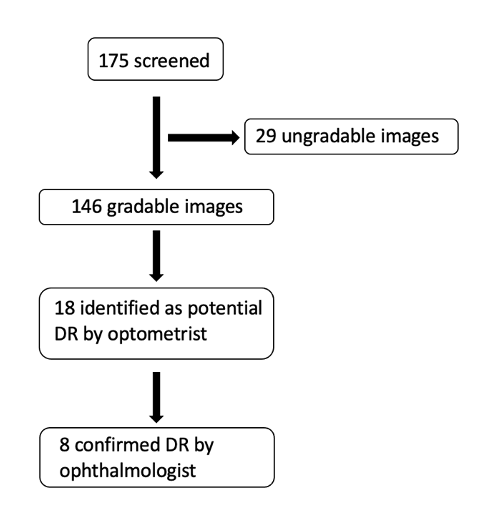Endocrinology: Type 1 Diabetes (T1 DM)
Endocrinology 1
181 - Interprofessional Model for Point of Care Retinopathy Screening in Pediatric Patients with Insulin-dependent Diabetes
Saturday, April 29, 2023
3:30 PM - 6:00 PM ET
Poster Number: 181
Publication Number: 181.213
Publication Number: 181.213
Michael C. Mohnasky, University of North Carolina at Chapel Hill, Chapel Hill, NC, United States; Michelle C. Curl, UNC Health, Chapel Hill, NC, United States; Nina Jain, University of North Carolina School of Medicine, Department of Pediatrics, Chapel Hill, NC, United States
- MM
Michael C. Mohnasky, MBS (he/him/his)
Medical Student
University of North Carolina at Chapel Hill
Chapel Hill, North Carolina, United States
Presenting Author(s)
Background: Diabetic retinopathy (DR) screening guidelines for pediatric patients with diabetes ideally identify those at risk for vision loss, allowing for early, targeted interventions. However, adherence rates to these guidelines are poor. The burden of additional appointments causing missed school/work is a major screening barrier.
Objective: The purpose of this study was to measure the effectiveness of offering a non-mydriatic fundus camera as a point of care service to increase the adherence of pediatric patients to DR screening guidelines.
Design/Methods: 175 patients with insulin dependent diabetes mellitus aged 10-17 were screened using a non-mydriatic fundus camera between September 2019 and March 2022 at a pediatric endocrinology clinic. Patients were offered screening by members of the interprofessional team (nurses, medical assistants, and dieticians) as part of their normal appointment. An image was taken of each retina and sent to an optometrist who forwarded images with suspected DR to an ophthalmologist for confirmation. Non-gradable images were not forwarded.
Results: Use of the non-mydriatic fundus camera raised the screening adherence rate of 17/419 (4.1%) patients seen in the year prior to intervention to 80/222 (36.0%) patients seen at 5 months post-implementation (Figure 1). Of 175 screened, 146 had gradable images (83.4%). Of these, 18 (12.3%) had suspected DR and 8 (5.5%) were confirmed to have mild non-proliferative DR (Figure 2).
Conclusion(s): Point of care screening with a non-mydriatic fundus camera yielded a large increase in the proportion of patients fulfilling recommended DR screening. Trained clinic staff demonstrated an ability to perform retinal imaging which represents an adaptable model for in-clinic screening in regions with limited access to specialized eye care. Additionally, reserving additional ophthalmologic appointments only for those with concerning findings places less burden on patients and ophthalmologists’ alike. This study supports increased usage of a non-mydriatic fundus camera delivered in an interprofessional context for improving DR screening rates.
.png)

